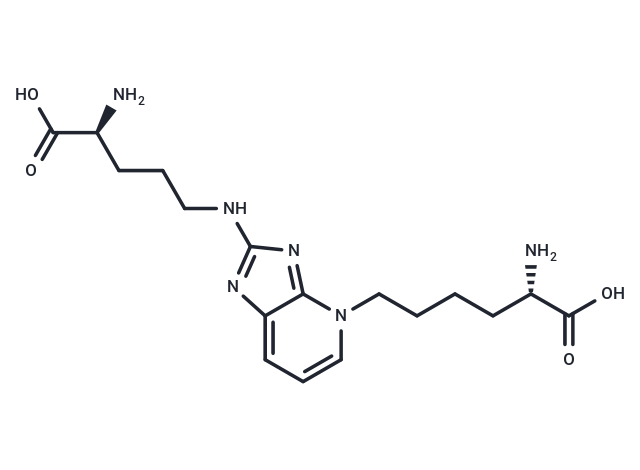Shopping Cart
- Remove All
 Your shopping cart is currently empty
Your shopping cart is currently empty

Advanced glycation end products (AGEs) are compounds formed by non-enzymatic chemical reactions following the bonding of sugars to proteins or lipids during diabetes, uremia, aging, rheumatic arthritis, and other conditions. A receptor for the AGEs (RAGE) binds certain members of this class to initiate cell signaling.[1][2] Pentosidine is a well-characterized natural AGE that is often used as a biomarker for the production of all AGEs. While pentosidine can be measured in urine, the majority of this AGE is catabolized before excretion.[3]

| Pack Size | Price | Availability | Quantity |
|---|---|---|---|
| 1 mg | $898 | Backorder | |
| 5 mg | $3,980 | Backorder | |
| 10 mg | $5,080 | Backorder |
| Description | Advanced glycation end products (AGEs) are compounds formed by non-enzymatic chemical reactions following the bonding of sugars to proteins or lipids during diabetes, uremia, aging, rheumatic arthritis, and other conditions. A receptor for the AGEs (RAGE) binds certain members of this class to initiate cell signaling.[1][2] Pentosidine is a well-characterized natural AGE that is often used as a biomarker for the production of all AGEs. While pentosidine can be measured in urine, the majority of this AGE is catabolized before excretion.[3] Reference:[1]. Neeper, M., Schmidt, A.M., Brett, J., et al. Cloning and expression of a cell surface receptor for advanced glycosylation end products of proteins. The Journal of Biological Chemisty 267(21), 14998-15004 (1992).[2]. Brett, J., Schmidt, A.M., Yan, S.D., et al. Survey of the distribution of a newly characterized receptor for advanced glycation end products in tissues. American Journal of Pathology 143(6), 1699-1712 (1993).[3]. Miyata, T., Ueda, Y., Horie, K., et al. Renal catabolism of advanced glycation end products: The fate of pentosidine. Kidney International 53, 416-422 (1998). |
| Molecular Weight | 378.433 |
| Formula | C17H26N6O4 |
| Cas No. | 124505-87-9 |
| Storage | Powder: -20°C for 3 years | In solvent: -80°C for 1 year | Shipping with blue ice. | |||||||||||||||||||||||||||||||||||
| Solubility Information | PBS (pH 7.2): 10 mg/mL (26.42 mM), Sonication is recommended. DMF: 21.4 mg/mL (56.55 mM), Sonication is recommended. Ethanol: 31.3 mg/mL (82.71 mM), Sonication is recommended. DMSO: 22.4 mg/mL (59.19 mM), Sonication is recommended. | |||||||||||||||||||||||||||||||||||
Solution Preparation Table | ||||||||||||||||||||||||||||||||||||
PBS (pH 7.2)/DMF/DMSO/Ethanol
DMF/DMSO/Ethanol
| ||||||||||||||||||||||||||||||||||||

Copyright © 2015-2025 TargetMol Chemicals Inc. All Rights Reserved.